What A Show!
by Mike Guthrie, West Coast Correspondent (and dam lucky guy!)
Reprinted from "Crown Jewels of the Wire", January 1994, page 6
AUBURN, CALIFORNIA 1993
Ok, beautiful country, great weather, nice people, neat stuff, 135 sales
tables, and 10 collectible displays. So, what else is new, Auburn is always a
great time..... always.
But this year was a cut above......
DALE HUBER of Grass Valley, CA called it a "wild card" show...
something wild always shows up.
It started Friday night. A CD 736 N.Y. & E.R.R. threadless dug in
California turned up for sale and was snagged for a collection. (The eastern
piece found its way to installation in the west.) And then STEVE VIOLA was
checking out one of the tables and found a CD 120 in aqua with the numbers 300
on the price sticker. Did I mention that it was an unembossed C.E.W.? This piece
is rarely seen, in fact I've never seen one for sale. In checking his price
guide, Steve saw $500-600 and started asking around if it was really worth that
much. Upon being assured that it was indeed scarce, he verified the price before
buying the piece .... for $3.00! ! !
The next "wild card" showed up
with LOU DIEKE who, last year, brought in one of the two Batchelder Patents
pictured in the February 1993 Crown Jewels (p.34). The Batchelder is the first
patented (Oct. 14, 1851) line insulator for which specimens are known. Not
satisfied with just one, Lou continued digging on the line and this year produced
four partial specimens. Not only was the existence of four of these rarities at
one time phenomenal, he had three different styles!!! There were two of the
screw shank variety (p.34), one suspension style (p.35) and a new style which
had a ramshorn type of wire attachment arrangement at the end of the shaft.
As
if this wasn't enough excitement for one night, LARRY MONROE acquired a fluted
cobalt Cal Electric (CD 130.1) and a second one made a first time appearance.
On
Saturday, things picked up where they left off the night before. DAVID KEILMAN
was showing the Gregory (CD 159) which he and hunting companion TONY CARPENTER
found on the C.P.R.R. right-of-way near Donner Lake. Not long after, JIM AND
LAURENE RIVES approached FRED PADGETT with a second Gregory which had the dome
missing above the top of the pinhole. Jim was trying to determine a fair value
for the Gregory with damage so Fred brought Jim to my table to have me look at
the piece. Incidentally, Jim had acquired the piece for $1.00!! It was better
than most having 5 out of 8 wire groove corners in mint condition. While
pondering the difficult question of how much is a broken rare insulator worth,
Jim said that he had another piece he wanted some information on, as he started
to unroll a small paper sack. Not knowing what to expect, I hastily put the
Gregory down and prepared my hands to receive the sure to be amazing piece. When
it came out of the bag and I began to examine it, I nearly wet my pants!
It was clearly one of the most incredible insulators I have ever seen.

Fig. 1 (above) shows the new insulator style from the front.
It is similar in size to a pony insulator. The two short "arms" are
seen at the left and right side in front of the notched dome.
As I
quickly learned, trying to paint a word picture over the telephone was virtually
impossible. Words like: 'It's light green, looks like a pony with a
notch in the dome surrounded by two arms with no wire groove and a wire path
that looks like the Greek letter "Omega" with "Pat. Apl'd
For" embossed vertically on the skirt' just didn't seem to do it, so I will
have to let the photographs speak for me.
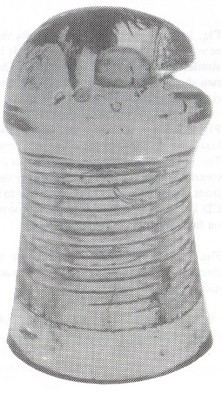
Fig. 2 (above) shows the insulator at one-quarter of a full
turn. The wire groove notch on the dome is clearly visible and the short arm
in
the front. The rear of the dome is similar to a CD 102 pony but there is no wire
groove on that side.
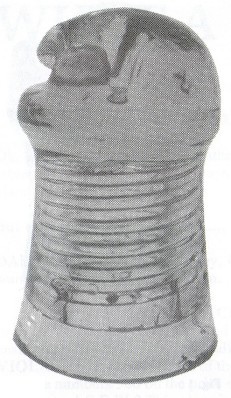
Fig. 3 (above) shows the insulator at three-quarters of a full
turn. It is an
exact mirror image of Fig. 2.
After an hour or two of bid seeking
and discussions, the new baby was purchased by MIKE GUTHRIE (me) and DWAYNE
ANTHONY in a cooperative venture. In investigating the pedigree of the piece, I
was able to determine the following. Jim Rives bought the piece with several others at a garage sale about two months prior
to the show. Purchase price was $2.00 ! ! ! The seller lived not far from Auburn
and apparently has no clue as to its origin. RON SOUZA, noted insulator
researcher, shared that he had heard a number of stories about a pony "with
knobs on the top" having been unearthed by a bottle digger about 20 years
ago. Since it did not say "C.E.W." on it, Ron never pursued it. DON GAYLORD thought he had seen the piece a number of years ago at the Chico Show,
possibly as a show and tell item. Beyond this limited background, little else
could be determined about the new find other than it bore some evidence of
having been buried.
Suffice it to say, it is one of the most incredible
discoveries of an American piece in some time. Efforts will probably be made to
have N. R. Woodward examine the specimen to consider assignment of a new CD
number but transportation of the piece will have to be worked out first.
As
astounding as the above events are, it didn't end there. After the show, I
learned that another great piece 'walked-in, on Saturday after the 'Pat. Apl'd
For'. An aqua Seiler's patent (CD 130.2) showed up with a gentleman who was
trying to determine its worth. Except for burial stain it was mint! As of this
writing its purchase has not been consummated but needless to say, negotiations
are underway.
All in all, Dale Huber called it right when he said it was a "wild card show".
If it gets any wilder,
we'll need paramedics to standby to resuscitate the crowd!
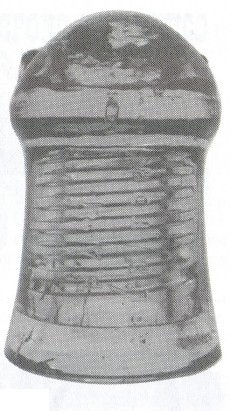
Fig. 4 (above) shows the insulator from the back side. You can see a
good
portion of the one "arm" peeking over the top of the dome at the left
and just the tip of the other "arm" at the right of the dome. The
really unique embossing is vertical on the skirt of the insulator and reads:


Fig. 5 (above) This photo was taken with the "new CD" on the left
and a CD 109.5 Harloe "baby claw" at its right. There is a striking
resemblance between the two insulators. Their body shapes are very similar and
the "no tie wire" type of service application is somewhat consistent.
The Harloe design, however, would appear to have been more successful than the
new find's configuration.
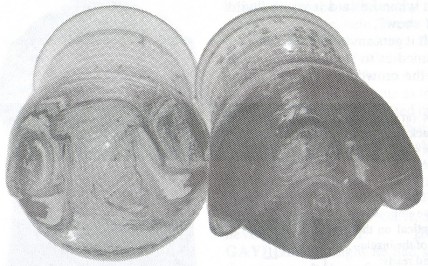
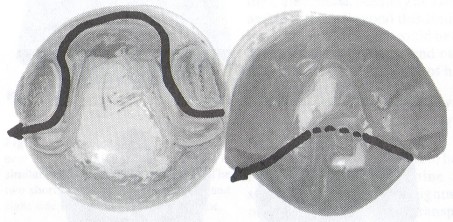
Fig. 6 and Fig. 7 show the "new CD" (left) and the CD 109.5 Harloe
(right) from a view looking down at the two dome tops. In Fig. 7, a black line
has been drawn on both of the dome tops to indicated the path the line wire
would take when installed between the two arms and dome "nose" of the
new insulator find and the three "claws" of the Harloe.
Maybe we should nickname this "new find" the DW-IKE (for Dwayne
and Mike -- the current owners). However, we will wait for analysis and CD number
assignment from N.R. Woodward in the coming months.
Until that time, there will be many conjectures about the new insulator's
origin. Your editor and Mr. MAC are betting it is a Hemingray product that went
West with a couple of early Seilers insulators. What do you all think???
| 